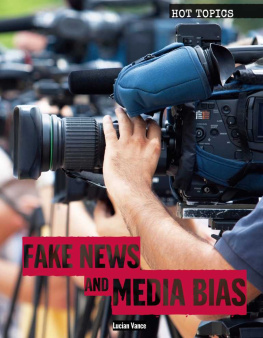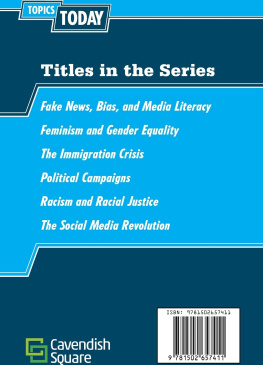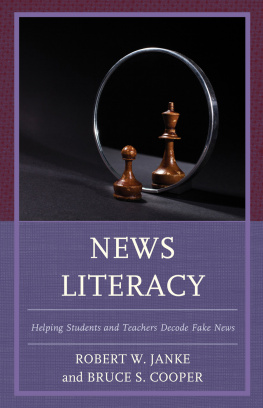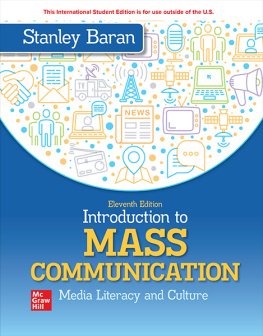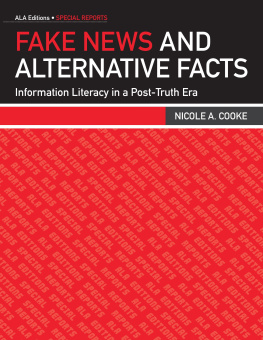
FIGHTING FAKENEWS!
FIGHTING FAKENEWS! Grades 4-6
Teaching Critical Thinking and Media Literacy in a Digital Age
BrianC.Housand,Ph.D.

First published in 2018 by Prufrock Press Inc.
Published 2021 by Routledge
605 Third Avenue, New York, NY 10017
2 Park Square, Milton Park, Abingdon, Oxon OX14 4RN
Routledge is an imprint of the Taylor & Francis Group, an informa business
Copyright 2018 by Taylor & Francis Group
Cover design by Raquel Trevino and layout design by Micah Benson
All rights reserved. No part of this book may be reprinted or reproduced or utilised in any form or by any electronic, mechanical, or other means, now known or hereafter invented, including photocopying and recording, or in any information storage or retrieval system, without permission in writing from the publishers.
Notice:
Product or corporate names may be trademarks or registered trademarks, and are used only for identification and explanation without intent to infringe.
ISBN 13: 978-1-0321-4237-1 (hbk)
ISBN 13: 978-1-6182-1728-8 (pbk)
DOI: 10.4324/9781003235200
TABLE OF CONTENTS
Guide
ACTIVITY GUIDE
CHAPTER 1
THE WORLD OF FAKE NEWS:
DOI: 10.4324/9781003235200-1

It is said that there is an ancient Chinese curse: May you live in interesting times. As we consider the world that we are living in today and all that is happening around us, we are definitely living in interesting times. We are constantly bombarded with a deluge of news and information through an ever-increasing variety of technology outlets. From radio and television, to computers and mobile devices, we are seldom, if ever, truly unplugged from the technology and media that surround us.
Today's technology has given us unprecedented access to information and equipped us with powerful tools for creativity and communication. Yet, we must ask the question, "At what cost?" As technology advances and becomes more personalized, do we sacrifice our privacy for the sake of the future? Do we blindly trust in our tools and online resources to provide us with the most relevant and up-to-date information possible? At what point do we begin to question what we are reading online?
As we consider this "ancient Chinese curse," we should also begin speculating about its origin and authenticity. In the digital age, each of us carries a powerful tool for locating information. A quick Google search immediately casts a long shadow of a doubt on the origin of this phrase that many have simply taken for granted for decades. Despite making its way into numerous speeches delivered by the likes of Albert Camus, Arthur C. Clarke, and Robert F. Kennedy, there is no solid evidence that this is even of Chinese originlet alone an ancient curse.
Yet, why have we willingly accepted this quotation as fact? Do we believe it because it fits our schema, or do we believe it simply because we want to believe it is true? Maybe we believe it because it makes an interesting story, or are we willing to believe anything that we read?
I warn you of this ancient Chinese curse because we have always and will always live in interesting times. The interesting times of today are not necessarily that different than the interesting times of yesterday or even 100 years ago. We are all too quick to revel in the "good old days" without admitting that they were probably not as "good" as we remember them. Today's times may seem more interesting and even dire because we are currently experiencing them, or perhaps they seem more interesting because we are beginning to pay attention to what is happening around us.
A BRIEF HISTORY OF FAKE NEWS
As we look at our world today, we hear the constant cry of fake news. Claims come from our social media feeds, 24-hour cable news channels, and even the Trump White House. The rise of such claims and alternative facts during the 2016 presidential election led to post-truth being proclaimed as the 2016 Oxford Dictionaries Word of the Year. The term is defined as "relating to or denoting circumstances in which objective facts are less influential in shaping public opinion than appeals to emotion and personal belief." With 2016 events such as the Brexit vote and the U.S. presidential election, use of the term increased by approximately 2,000% more than its usage in 2015.
As we have always lived in interesting times, the concept of fake news has been around a lot longer than we may have realized.
In a 2016 POLITICO Magazine article, Jacob Soll related "The Long and Brutal History of Fake News" and advised us that, "Bogus news has been around a lot longer than real news. And it's left a lot of destruction behind" (para. 1). According to Soll, fake news began circulating with the introduction of the Guttenberg Press in 1439. News sources of the time ranged from religious authorities and political organizations to supposed eyewitness accounts of sailors and merchants. Yet, there were no standards for journalistic integrity or ethical behavior. Instead, readers had to pay close attention and determine what the real story might be. Because the technology of the day was in the hands of a few, a great deal of value was placed in what was printed.
As printing technology expanded over the next 300 years, so did fake news. By the mid-1700s, "newsworthy" accounts of sea monsters and witches abounded. There were numerous reports by churches and European authorities blaming sinners for natural disasters, including the 1755 earthquake in Lisbon, Portugal. These claims prompted Voltaire to advocate against fake religious news.
Meanwhile in the American Colonies, Soll (2016) pointed out that even our Founding Fathers were perpetrators of fake news for political advantage, as Benjamin Franklin "concocted propaganda stories about murderous 'scalping' Indians working in league with the British King George III" (para. 10). It was fake news stories such as these that helped to compel colonists to enlist to fight in the Revolutionary War.
Throughout history, fake news has proved to be financially rewarding for its publishers. In the 1830s, there was a rise in popularity of "penny press" newspapers that cost only one cent and featured a narrative style of reporting that attracted a wider audience than more traditional newspapers. In August of 1835, The Sun, a New York newspaper, published a series of stories over 6 days that reported that well-known British astronomer Sir John Herschel had constructed a powerful telescope that allowed him to view life on the moon. The paper provided extensively detailed descriptions and illustrations of the vegetation and animals, including single-horned goats and beavers that for some reason walked on two feet. There were also descriptions of human-like creatures with wings and pyramid structures that formed this advanced civilization. As a result of these fantastical stories, sales and subscriptions flourished. Although many competing newspapers were quick to point out that this was mere fantasy, other newspapers around the world reprinted the stories as fact. The Sun never admitted that the stories were fake news, but instead, the Great Moon Hoax helped it become a successful newspaper.
Next page

